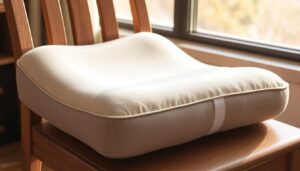Being a caregiver comes with many challenges, like choosing between standing and sitting for baby care. Babies start to stand and walk between 7 to 16 months. Your help is key in their development. It’s also important to think about your comfort and the baby’s safety at home.
When it comes to baby care, safety and comfort are top priorities. Whether you’re changing diapers or playing with your baby, the right position is crucial. Standing and sitting each have their own benefits and risks. Choosing the right position helps keep you and your baby safe and happy.
Key Takeaways
- Understanding the significance of baby care positions affects both the caregiver’s comfort and the infant’s development.
- Infants typically progress to independent standing between 7 to 16 months, with caregivers offering necessary support.
- Safety and comfort are paramount in deciding whether standing or sitting during baby tasks.
- Both standing and sitting for baby care come with their unique benefits and potential risks.
- Ergonomic considerations are central to a safe and efficient baby care experience.
Introduction to Baby Care Positions
Learning about the best posture for baby care and ergonomic baby care positions is key. It helps as your baby grows and hits different milestones. From building leg strength to standing on their own, the right position is vital for safety and support.
Babies start their journey to standing early, often pulling themselves up and standing with support by 9 to 13 months. By 10 to 16 months, many can stand alone. Using ergonomic baby care positions helps in this journey. It offers comfort and the right support for their body.
| Age | Milestone | Recommended Position |
|---|---|---|
| 0-3 months | Early leg strengthening | Gently cycling legs while on back |
| 7-10 months | Pulling up to stand | Assisting with hands-on support |
| 9-13 months | Standing with support | Using stable furniture for self-assistance |
| 10-16 months | Standing independently | Minimal assistance, monitoring safety |
This guide shows how using the best posture for baby care in daily life can greatly benefit your child. It can positively impact their well-being and physical growth.
Is it better to sit or stand for baby care
When caring for a baby, you often wonder about the optimal positioning for baby care. Standing or sitting each has its own benefits. These benefits help in your child’s development and safety, and also support your health.

Benefits of standing for baby care
Standing while caring for your baby uses proper body mechanics for baby care. It helps keep your back straight and reduces strain. This position keeps you active and ready to move when your baby needs you.
When your baby starts moving, standing helps you guide them safely. It’s key for their physical growth.
Advantages of sitting during baby task routines
Sitting has many benefits of sitting for baby care. It lets you keep eye contact and connect face-to-face with your baby. This is vital for their social and emotional growth.
Sitting also gives a stable base for your baby as they learn to sit. Your care and support in this position boost their confidence and skills. Plus, it’s safer because it reduces the risk of falls.
Ergonomic Baby Care Positions
When caring for an infant, using ergonomic positions can greatly reduce physical strain. Knowing optimal positioning for baby care helps you stay comfortable. It also keeps your baby safe and supports their growth.
Using proper body mechanics for baby care means keeping a posture that avoids strain. Whether lifting, feeding, or soothing your baby, each action should follow ergonomic rules. This ensures safety and efficiency.
Optimizing ergonomics in baby care tasks
Improving ergonomic baby care positions involves changing how you interact with your baby. This includes how you hold, feed, and play with them. For example, when feeding, sit comfortably with back support if you can. This reduces back strain.
Also, when lifting your baby, bend at your knees, not your waist. This helps prevent back injuries.
Proper body mechanics for baby care
Proper body mechanics are more than just lifting right. It’s about moving and positioning yourself in baby care tasks to avoid injuries. For example, when changing diapers, make sure the changing table is at a height where you can stand without bending.
When holding your baby, use both arms to spread out the baby’s weight. Also, switch sides often to balance the load.
- Ensure all interaction with your infant is done with minimal twisting of the spine.
- Regular breaks are crucial to prevent muscle fatigue, even in the middle of care routines.
- Adjust the height of surfaces like changing tables to match your stature, reducing the need to bend.
Remember, adopting ergonomic baby care positions and proper body mechanics are not just about comfort. They also create a healthy environment for you and your baby.
Practical Tips for Choosing the Best Posture for Baby Care
When caring for a baby, finding the right balance is key. You need to know when to sit and when to stand. This ensures the best care and support for your little one.
Transitioning between Sitting and Standing for Baby Tasks
Sitting is great for comforting, feeding, or playing at eye level. Standing is better for lifting, changing, or soothing during active times. Switching between these positions helps prevent back pain and supports your baby’s growth.
Encourage activities that make your baby move. For example, place toys just out of reach during play. This helps their muscles grow and improves best posture for baby care.
Creating a Safe and Efficient Baby Care Space
A safe and efficient baby care space is crucial. Make sure all furniture is stable to avoid accidents. Remove hazards and keep important items within reach for easy transitions.
Place toys and accessories in a way that encourages safe movements. Soft mats or carpeted areas are great for standing practice.

In conclusion, managing transitions and arranging the care area well is important. It ensures safety and promotes healthy development. Use the right postures and adjustments to create a loving and supportive environment.
Conclusion
Parenting is a rewarding yet demanding journey. Mastering baby care positions is a subtle but significant element. It can greatly enhance the experience for both you and your little one.
Understanding when to use ergonomic baby care positions is key. It’s not about strict rules but about responding to your baby’s needs and your own wellbeing. Whether sitting or standing, the goal is to ensure your infant’s safety, comfort, and the promotion of their growing motor skills.
Ergonomic baby care positions can help prevent physical strain. This makes parenting tasks easier and safer. By being adaptable, you create a nurturing environment that grows with your baby.
Proper body mechanics for baby care also play a crucial role. They ensure your baby is supported in a way that’s good for their health and happiness.
Your ability to adapt to different baby care positions is crucial. It helps you and your child grow together harmoniously. Every action, every choice of posture, adds to the overall care you provide.
By observing and responding to both your needs and your baby’s, you make every moment count. Every lift, every cradle, and every transition is a step towards a more loving upbringing.
FAQ
Is it better to sit or stand for baby care?
What are the benefits of standing for baby care?
What are the advantages of sitting during baby task routines?
How can ergonomics be optimized in baby care tasks?
Why are proper body mechanics important in baby care?
How can caregivers effectively transition between sitting and standing for baby tasks?
How can I create a safe and efficient baby care space?
Related Posts
- How to Sit Comfortably After a C-Section
- How to Sit Comfortably at Work While Pregnant
- Postpartum Belly Wraps: Do They Really Work?
- Nursing Pillows That Protect Your Back
- Postpartum Ergonomics for Moms Returning to Remote Work
- Contact Ergomomics
- Best Pregnancy Pillows for Back Pain Relief
- Affiliate Disclosure







